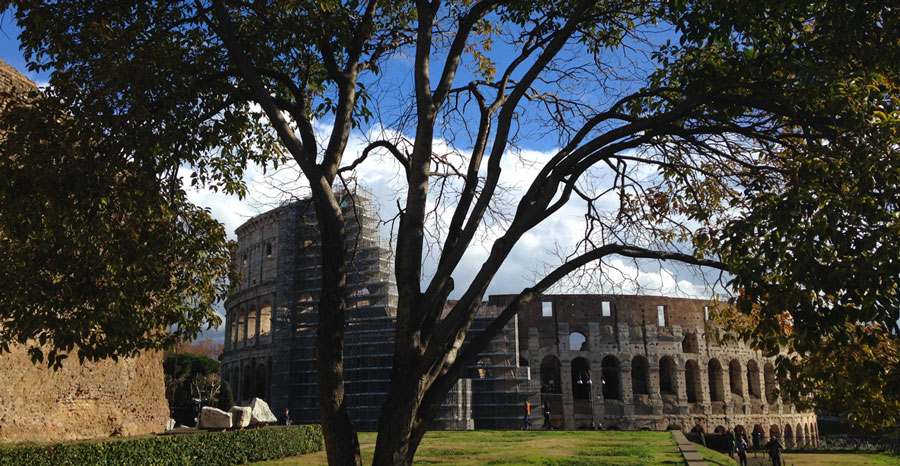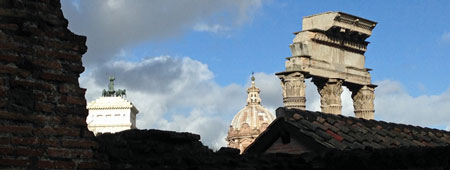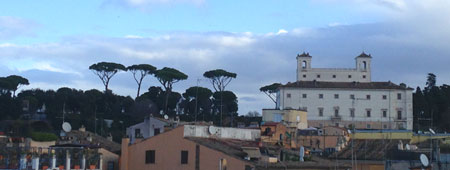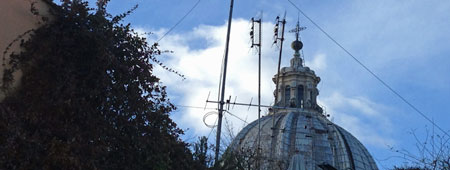
CdP
12 January 2016
It’s incredible how light is so determining. One morning last week I opened the shutters to find a dull, numbing grey rather than the kind of knock-you-sideways dazzle that had been half-blinding me and filling me with joy through more sunny mornings in a row than I can ever remember in the depths of winter. All that first glum day I stomped about in a foul mood, snapping. I didn’t mean to: it was più forte di me (stronger than me).
Ever since, it has been a meteorologically determined big dipper of despair and euphoria, the lowest point being those few days when the fog reversed itself. Down in the valley beneath CdP – in Po’ Bandino, Chiusi Scalo, along towards Castiglione del Lago – there are weeks on end in winter when the sun never breaks through the swamp of mist that settles there. The denizens of that netherworld live in a damp shadow land. Up here on the hill on the other hand, we bask in light-filled glory, smugly surveying the great mist-bowls that fill the valleys from about 400m downwards. At night, when lights below make pools of glowing mystery in the whiteness, it really looks quite magical from above.
Then for a couple of days the fog-altitude shifted: it was still cloudy down in the valley, obviously, but the dense, clinging stuff hung right around us. The initial comfy feeling of being in a special space of swirling cotton wool gave way to claustrophobia after precisely two minutes.
In Rome last week, only one downpour interrupted our 24-hour stay. It was another ‘work’ trip for L (with C and I as baggage), and we stayed in the two suites of La Scelta di Goethe.
It’s appalling how familiarity breeds unforgiveable blasé-ness. There was I thinking ‘why on earth would anyone want to pay unthinkable amounts of money to stay on via del Corso?’ For me, via del Corso means struggling through heaving waves of humanity, all jostling in every direction to get to photocopy high-street purveyors of tacky high-street clothes – a thoroughfare which I’ve abandoned entirely on many occasions in the past when the wall of flesh and imperious shopping bags made it impossible to get through on my bike. Then I read the comments in the Scelta di Goethe guest book – about the joy of being immersed in this couldn’t-be-more-central bit of the centro storico, the extraordinary sights right there on the doorstep, the wonder of feeling immediately part of the living city – and was rather ashamed of my jaded Roman cynicism.
As we were being put up in a place named (despite no apparent connection other than being more or less in the vicinity of where he stayed) for Goethe, we decided to honour the great German with a visit to the Casa di Goethe which quite inexplicably neither of us had been to. This little house-museum is charming, and had a show about Emma Hamilton on as a bonus. It’s not a ‘house’ in the sense that there’s no period furniture or bits of well-used blotting paper lying about on desks used by the writer. But it does have a homely feel nevertheless, and the items and artworks displayed are quaintly interesting. Most surprising are some of Goethe’s own sketches which are more early 20th than late 18th century.
It was while we were in Rome that the Italian papers were cock-a-hoop at the news that the Colosseum-Forum-Palatine complex was the world’s second most visited tourist attraction after the Great Wall of China. C and I had already decided to help ticket sales: only a few days remained to see the Rampa imperiale, Domitian’s mighty ramp from down in the Roman Forum up to his Palatine palace.
The light was spectacular (except during the sudden storm which soon passed on), the place wasn’t too crowded considering it was a public holiday, the ruins were looking magnificent and the ramp really was worth making a special trip for. But. Why does Rome always throw up a ‘but’? There were no signs to the ramp during this special temporary opening (we had to ask several custodi for directions… difficult in itself as they are hard people to locate); in fact there were very few signs to anything, and many of them were way off behind seemingly random bits of iron fencing; the paths had probably once been gravelled but are now rutted tracks punctuated by an obstacle course of muddy puddles; every now and then, from a vantage point, a row of straggly and quite inexplicable roses hove into view, the locations seemingly chosen for minimum impact.
Now, bear with me while I do some wildly over-simplified calculations. Six million-odd people each paid €12 to visit last year = €72 million. Of course there’s no denying that there are a lot of overheads in a site like that: many many employees (however difficult they are to find…) and upkeep (again, difficult to discern much of that) and research and what have you. Presumably there are people who are paid to look after the vegetation (such as it is) and to deal with customer services (I’m trying to remember: is there even a bookshop at the main via dei Fori Imperiali entrance? If there is, it certainly doesn’tgrab your attention). If it’s not a budget problem, then it’s a management calamity. I wonder what state the Great Wall of China is in…
The soaring, vaulted Rampa imperiale spins its own telling little tale. It was discovered in 1901, and a 13th-century church was demolished to free it (and the buried church of Santa Maria Antiqua) up. Without the tiniest hint of irony – never mind apology or indeed shame – all the official bumph hails this glorious opening after ‘a lengthy architectural and archeological restoration’. Lengthy. One hundred and fifteen years. Granted, Rome wasn’t built in a day but this kind of ‘lengthy’ is hard to justify.
The rampa is magnificent, just as Mary Beard had enthused in a lecture attended by C’s friend Francesca in Edinburgh recently: the reason we knew it was open. But Mary, we decided when we came to an abrupt halt on rather a low landing of the rampa – well below the imperial palaces further up – must have been given a VIP tour. After this 115-year restoration mere mortals were given a ten-week window to glimpse less than half of the thing. The rest, a diagram up there told us, is still ‘in restauro’. Come on Rome. You can do better than this. Or will we be made to wait another 115 years perhaps?
In the Lidl down in the valley, I’ve been waiting in a long queue to pay. The lady in front of me has piled the conveyor belt with unthinkable amounts of the cheapest possible thoroughly processed food. (The lone net of special-offer mandarins looks oddly out of place.) She’s maybe in her early 60s, down-at-heel, giggling quietly to herself from time to time and shuffling.
It’s no surprise at all when the boy on the till runs her credit card through the machine and announces that it has been refused. The lady feigns amazement and shock. The boy is as unconvinced by her performance as anyone but kindly (because people around here are kind, even the ones in Lidl) runs it through a couple more fruitless times, with the same result. Groans of despair and little gasps of ‘oh this is terrible, this has never happened before, what on earth will I do?’
Meanwhile the queue keeps growing.
She empties her wallet and counts out a few notes and many many coins, reaching €8 or so. And the boy begins the task of reverse-running about €30 worth of items back through the register, consulting her gently on each – asking whether she can do without it, and explaining how much closer to €8-odd it’s going to shift her if she relinquishes it.
Further up the line, people are watching the process with amusement and/or fascination. (In Britain they would be either mortally embarrassed or tuttingly infuriated.) Many are sympathetic; a couple have there-but-for-the-grace-of-God looks on their faces. No one is complaining… except the old bloke right behind me.
“Plastic,” he mutters. “Plastic. Those plastic card things. What’s the point of them? No use at all. Never work. Never.” He’s talking to everyone and no one, a kind of undirected pontificating which not only ignores overwhelming evidence to the contrary, but utterly misses the point of the scene unfolding at the till. “Refuse to have it in my house. Never used it in my life.” I’m doubting that he has the kind of credit record which would make a bank manager feel comfortable issuing him a card anyway. “What’s wrong with cash, eh? And what do people need all those machines for, eh? Computers? What good did they ever do anyone?”
I tune out when he begins his assault on IT, focussing instead on the interminable process of whittling away at the pile of purchases. Finally it’s done. I can pay for my two avocados. Had I been sensible, I would have abandoned them and stalked off, but that would have seemed churlish and – I admit it – the scene was too gripping. Does this mean I’m going seriously native?



